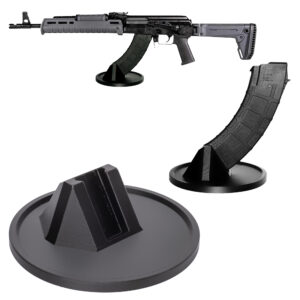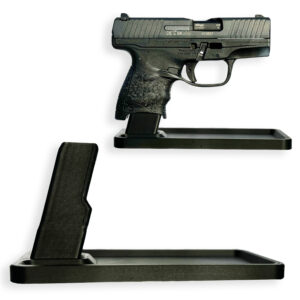Categories:
The AR-15, originally designed in the 1950s by ArmaLite and later adapted by Colt, has become one of the most iconic guns in the United States. Known for its versatility, modularity, and resemblance to military-grade rifles, the AR-15 enjoys a significant place in American gun culture. The sales trends of AR-15 rifles have been shaped by a variety of factors over the years, including legislative actions, societal shifts, and market dynamics.
The popularity of the AR-15 has been both bolstered and challenged by political discourse and legislation. In times of impending or perceived gun control, sales often see dramatic increases, driven by a phenomenon known as the “fear buy.” This trend is pronounced when there is talk of bans or restrictions, as consumers rush to purchase guns before new regulations possibly come into effect.
Conversely, periods of political stability regarding gun regulation might see a decrease or stabilization in sales, as urgency diminishes.
The influence of social and economic factors on AR-15 sales is also considerable. The rise in recreational shooting sports, along with competitive and tactical training events, has contributed to the sustained interest in AR-15 rifles. These activities often showcase the gun’s adaptability and performance, further cementing its appeal across various demographic groups, from hobbyists to professionals.
Technological advancements in gun manufacturing have also impacted AR-15 sales trends. The proliferation of after-market parts and customizable options has allowed consumers to personalize their rifles extensively, which has broadened the market and attracted new buyers interested in tailoring guns to precise specifications. The increasing prevalence of direct-to-consumer sales models and online marketplaces has simplified access, thus contributing to the sales volume over time.
In summary, the AR-15 serves as a barometer for wider trends in the guns market, reflecting the interplay between political climates, cultural shifts, and technological advancements. As such, understanding the sales dynamics of this rifle provides insights into the broader narratives surrounding gun ownership in America.
Since its introduction in the late 1950s by the American company ArmaLite, the AR-15 rifle has undergone significant changes in both design and market perception, which have influenced its sales trends over the years. Originally developed as a military gun, the AR-15 was designed by engineer Eugene Stoner to be a lightweight, air-cooled, and readily adaptable rifle. It was initially not a commercial success, leading ArmaLite to sell the design to Colt’s Manufacturing Company in 1959.
Colt made several modifications to the original design, which facilitated its later adoption by the U.S. military as the M16 and helped solidify its reputation as a reliable, versatile platform.
In the civilian market, the AR-15 first gained traction in the 1960s and 1970s, buoyed by its association with its military counterpart. This period marked the beginning of its transformation into a popular sporting and self-defense gun. However, it wasn’t until the expiration of the Federal Assault Weapons Ban in 2004 that sales skyrocketed. The ban, which had been in place from 1994 to 2004, restricted the sale of certain semiautomatic rifles, including the AR-15.
After its expiration, manufacturers were quick to capitalize on renewed demand, leading to a proliferation of models and variants.
Throughout the 2000s and 2010s, AR-15 sales were further bolstered by several factors, including its modularity, which appeals to hobbyists and enthusiasts who enjoy customizing their guns. Additionally, the rifle became a cultural and political symbol, which, combined with periodic discussions about gun control legislation, often led to spikes in sales due to fears of potential restrictions. While AR-15 sales have faced criticism due to the weapon’s association with mass shootings, the market has remained robust.
This resilience is partly due to the efforts of gun manufacturers and advocacy groups that have framed ownership as an expression of constitutional rights. The AR-15 continues to be a polarizing and formidable fixture in the American guns market.
The sales growth of AR-15 rifles can be attributed to a confluence of factors that have shaped consumer demand and market dynamics. One of the primary drivers is the political climate, which has historically influenced gun sales in the United States. Whenever there is a perceived threat of increased regulation or potential bans on certain types of guns, including the AR-15, sales tend to spike.
This is often triggered by discussions or legislative proposals aimed at tightening gun control laws, prompting consumers to purchase guns out of concern that they might lose access to them in the future.
Another factor is the cultural significance and popularity of the AR-15 platform itself. Known for its versatility and modularity, the AR-15 has become a preferred choice for gun enthusiasts, hunters, and competitive shooters. Its ability to be customized to fit various needs and preferences makes it appealing to a broad range of consumers. Additionally, the AR-15’s strong presence in media, gaming, and its association with personal security and home defense has further solidified its position in American gun culture.
Economic conditions also play a role in gun sales trends. Economic uncertainty or periods of heightened tension, such as civil unrest or increased crime rates, can lead to a rise in gun purchases as individuals seek to protect themselves and their families. Conversely, an economic downturn might dampen sales to some degree, although the balance of fear and financial capability often maintains a consistent demand for AR-15s.
Marketing strategies and innovations by manufacturers, such as offering new models with advanced features or targeting specific demographics, also contribute to the growth in sales. As manufacturers strive to appeal to both novices and experienced gun owners, they deploy campaigns to highlight the AR-15’s attributes of reliability and performance, thereby sustaining its desirability.
Finally, the influence of gun rights advocacy groups cannot be overlooked. These organizations often amplify concerns about potential restrictions, thereby catalyzing movements to purchase guns, including the AR-15. These combined factors create an intricate web of influences impacting the sales trajectory of AR-15 rifles.
The geographic distribution of AR-15 sales in the United States reflects a confluence of cultural, political, and economic factors that vary regionally. Predominantly, states with more lenient gun laws and a strong culture of gun ownership experience higher sales of AR-15 rifles. This is particularly evident in Southern and Midwestern states, where hunting and gun sports are popular, and where there exists a deeply ingrained tradition of gun ownership.
States like Texas, Florida, and Arizona often report robust sales figures due to their larger rural areas and a political climate that favors the Second Amendment rights.
In contrast, states in the Northeast, such as New York and New Jersey, as well as some on the West Coast, including California, exhibit lower sales levels. This is largely a result of stringent gun laws and regulations that limit the availability and distribution of the AR-15. These states often impose strict background checks, mandatory waiting periods, and outright restrictions on specific modifications to semi-automatic rifles, which can dampen consumer enthusiasm and limit access.
Urban areas generally demonstrate lower sales compared to rural regions across the country, a pattern attributed to differing attitudes toward guns, levels of gun violence, and more rigorous local law enforcement policies. However, there are urban centers with robust gun markets, influenced by factors such as regional demand for personal protection and historical gun culture. Online sales have also introduced a broader distribution channel, affecting the geographic spread by allowing buyers in restrictive states to purchase components and assemble rifles with fewer regulatory hurdles.
The political climate following mass shooting incidents often influences geographic trends, as legislative responses in certain states either curb or escalate sales. For example, perceived threats of increased regulation after high-profile incidents can spur spiked sales in anticipation of new laws. This complex interaction of local legislation, cultural norms, and external events continually shapes the geographic distribution of AR-15 sales across the United States.
Legislation significantly impacts AR-15 sales trends, as various state and federal regulatory measures can either constrain or stimulate the market for this gun. When trying to understand the fluctuating trajectory of AR-15 sales, one must consider the relationship between enacted laws, consumer sentiment, and the broader political climate. Regulatory measures often arise following high-profile incidents of violence, leading to heightened debates on gun control and consequent legislative proposals.
For instance, the introduction of stricter background check laws or outright bans on certain semi-automatic weapons like the AR-15 typically results in a rush of purchases, as gun enthusiasts and consumers seek to acquire the weapon before new regulations take effect. This phenomenon is often referred to as “panic buying,” where anticipated restrictions drive a short-term surge in sales.
Conversely, when legislative efforts to tighten gun laws stall or fail, there could be a stabilization or even a downturn in sales, as the immediate impetus for purchase wanes. Additionally, states with more permissive gun laws see a relatively steady stream of sales, while states with stringent restrictions experienced reduced availability and, sometimes, a thriving black market. Another dynamic to consider is the impact of political rhetoric.
Statements made by political figures advocating for gun control can lead to increased sales, regardless of whether actual legislation is passed. Consumers anticipating future restrictions respond urgently even if changes are not immediately forthcoming.
In some cases, new legislation can also generate innovation in the guns market, encouraging manufacturers to develop compliant products that meet new legal criteria. This adaptability can be seen in the emergence of AR-15 models designed to circumvent particular state restrictions while maintaining high levels of consumer interest. In summary, legislation influences AR-15 sales through direct regulatory measures and indirect effects on consumer behavior and industry adaptation, highlighting the complex interplay between lawmaking and the guns market.
The AR-15, a popular semi-automatic rifle in the United States, has seen fluctuating sales trends influenced by multifaceted consumer demographics. Understanding these demographics is crucial for comprehending the broader patterns of AR-15 purchases. Historically, AR-15 buyers have predominantly been male, with various reports suggesting that ownership is significantly skewed toward men. This trend is often attributed to the traditional association of guns with masculine pursuits such as hunting and recreational shooting.
However, recent years have evidenced a shift with an increasing number of women purchasing AR-15s. This change is partly due to growing interest in self-defense and recreational activities such as target shooting and competitive sports, where the AR-15 is a popular choice because of its customizable nature and versatility.
Age is another defining factor in the demographics of AR-15 buyers. While older generations have typically formed the core of gun ownership in America, younger adults, particularly those between the ages of 25 and 40, are also significant purchasers of the AR-15. This younger demographic cites reasons such as home defense, sporting activities, and even political statements on Second Amendment rights as motivations for their purchases.
Regional differences further shape the consumer base, with higher sales often recorded in states with less restrictive gun laws. The AR-15 is particularly popular in rural and suburban areas, where a culture of gun ownership is more prevalent.
Socioeconomic status also plays a role, as the cost of AR-15s and related accessories may influence purchasing patterns. Middle to upper-middle-class individuals tend to dominate the consumer base due to financial capability to afford the gun itself as well as the associated costs of ammunition, accessories, and maintenance. While political and social factors heavily influence the larger trends, understanding the specific demographics is essential in grasping the nuanced landscape of AR-15 purchases and their implications in American society.
As societal attitudes shift, so too do the profiles of those purchasing AR-15s, reflecting broader trends in consumer behavior and societal values.
The future projections for the AR-15 market are inherently complex, shaped by an interplay of sociopolitical dynamics, regulatory changes, consumer preferences, and technological advancements. One of the key drivers in this market is the ongoing national debate surrounding gun control legislation. Any significant changes in federal or state regulations concerning assault rifles, such as bans, restrictions on sales, or mandatory buy-back programs, could profoundly impact the sales trends of AR-15s.
Stricter gun laws could potentially reduce demand, while periods of regulatory uncertainty often lead to short-term spikes in sales as consumers rush to purchase guns before potential restrictions are enacted.
Technological advancements in gun manufacturing may also influence future trends. Innovations that make the AR-15 more appealing, such as enhancements in materials leading to lighter and more durable models, or the integration of smart technologies, could bolster consumer interest. Furthermore, customizability continues to be a significant factor for consumers, who often view the AR-15 as a platform for personalization. As manufacturers expand their offerings of aftermarket parts and accessories, they may attract a broader customer base interested in customizing their rifles to meet specific needs or preferences.
Shifts in consumer demographics are another important consideration. The increasing diversity within the gun-owning population, including growing numbers of women and younger individuals, may drive changes in the market. These emerging consumer groups often seek guns for protection, sport shooting, or as a political statement, impacting the types of features and functionalities that are prioritized in new models.
Lastly, the export market for AR-15s could evolve, particularly if international interest in American-made guns rises. Changes in global security climates or shifts in international arms trade agreements could either facilitate or hinder such growth. Overall, while the AR-15 market faces uncertainty, its adaptability to various trends and factors will likely play a critical role in shaping its future trajectory.








Colt
Colt M4 Carbine
Colt LE6920
Colt AR-15 A4
Daniel Defense
DDM4 V7
DDM4 V9
DDM4 V11
DDM4 ISR (Integrally Suppressed Rifle)
Smith & Wesson (S&W)
M&P15 Sport II
M&P15 Tactical
M&P15T
Bravo Company Manufacturing (BCM)
BCM Recce-16
BCM Recce-14
BCM MCMR Series
Aero Precision
M4E1 Series
AC-15
AR15 Pistol (Various Configurations)
Ruger
Ruger AR-556
Ruger SR-556
Ruger AR-556 MPR (Multi-Purpose Rifle)
Springfield Armory
Saint Victor
Saint Edge
Saint AR-15
PSA (Palmetto State Armory)
PSA PA-15
PSA AR-V
PSA Jakl (AR Pistol)
FN America
FN 15 Tactical Carbine
FN 15 Patrol
FN 15 DMR
Wilson Combat
Recon Tactical
Super Sniper
Protector Carbine
SIG Sauer
SIG M400 Tread
SIG M400 Elite
SIG M400 SDI
LWRC International
IC DI (Direct Impingement)
IC SPR
IC A5
Bushmaster Guns
XM-15 QRC
Bushmaster MOE
XM-15 Patrolman
Rock River Arms
LAR-15 Entry Tactical
LAR-15 Predator
LAR-15 Elite Comp
Stag Arms
Stag 15 Tactical
Stag 15L (Left-Handed Models)
Stag 15 Valkyrie
Noveske Rifleworks
Noveske Gen 4 N4
Noveske Space Invader (AR Pistol)
Noveske Recon
Anderson Manufacturing
AM-15 Optic Ready
AM-15 M4 Carbine
AM-15 Precision Rifle
Adams Arms
AA-15 Piston Rifle
P2 AARS (Adams Arms Rifle Series)
Black Rain Ordnance
SPEC15 Series
BRO Predator
Fallout 15
Diamondback Guns
DB15 Series
DB15CCMLB
DB15EB
Del-Ton Inc.
DTI-15
Del-Ton Echo 316H
Sierra 316M
Windham Weaponry
Windham SRC
Windham VEX-SS
Windham RMCS-4 (Caliber Conversion System)
Christensen Arms
CA-15 G2
CA-15 Recon
CA-15 Titanium Edition
Patriot Ordnance Factory (POF-USA)
Renegade Plus
P415 Edge
Revolution DI
LaRue Tactical
PredatAR
OBR (Optimized Battle Rifle)
LaRue Stealth 2.0
Battle Arms Development
Workhorse Patrol Carbine
BAD556-LW (Lightweight)
Authority Elite Rifle
Faxon Guns
Ascent AR-15
FX-19 (AR Pistol)
Streamline Ultralight Series
KE Arms
KE-15 SLT (Super Lightweight Tactical)
KE-15 Scout Carbine
Primary Weapons Systems (PWS)
MK1 MOD 2-M
MK116 PRO
MK107 (Piston AR Pistol)
ZEV Technologies
ZEV Core Elite Rifle
ZEV AR15 Billet Rifles
Franklin Armory
BFSIII AR-C1
Militia Model
F17-L (Chambered in .17 WSM)
Seekins Precision
SP15 DMR
NX15 Skeletonized Rifle
Havak Bravo
Aero Precision (Additional Models)
EPC-9 (Pistol Caliber ARs)
VG6 AR Rifles
Barrett Guns
REC7 DI
REC7 Gen II
CMMG
MK4 RCE
Resolute 300
Banshee (AR Pistol)
DPMS Panther Arms
Panther Oracle
Panther LR-308
H&K (Heckler & Koch)
HK MR556A1
HK416 (Military Variant)
Rock Island Armory (Armscor)
VR-80 Tactical AR (Shotgun AR Platform)
Troy Industries
Troy SPC-A3
Troy PAR (Pump Action AR)
Wilson Tactical
Tactical Recon AR
Protector Series
F1 Guns
FDR-15 Skeletonized Rifle
BDRx-15 Series
Juggernaut Tactical
JT-15
JT-10 Precision Rifle
AeroSurplus
Surplus AR-15 Rifles (Budget Models)
Thunder Tactical
AR-15 Basic Carbine
Tactical Builder Sets
Radical Guns
RF-15
Forged AR-Series
Dark Storm Industries
DS-15 Featureless Rifles
DS-10 Typhoon
DRD Tactical
Paratus
Aptus AR Rifles
Bear Creek Arsenal
BCA-15
AR Complete Upper Builds
Aero Survival Rifles (ASI)
ASR Tactical Series
Tactical Edge
WARFIGHTER Series
AR-15 Lightweight Rifles
Lone Star Armory
TX15 DMR
TX15 Carbine
HERA Arms
HERA H7
HERA AR-15 Lower Builds
IWI (Israeli Weapon Industries)
Zion-15
DRD Tactical
Tactical Modular Rifles
Quick-Takedown Rifles
V Seven Weapons
1776 Rifle
Hyperlite Rifle
Core Rifle Systems
Core15 Tac III
Core15 Patrol Rifle
Armalite (Original AR-15 Creator)
M15 Tactical
M15 A4 Carbine
DEF15 (Defensive Sporting Rifle Series)
PSA (Palmetto State Armory Additional Models)
PSAK-47 Hybrid (AR-AK Style Hybrid)
PSA Dagger (Pistol Caliber Configurations)
Odin Works
OTR-15
Odin Recon Rifle
Maxim Defense
MDX-508 PDX (Compact AR Pistol)
MDX-510 Rifle